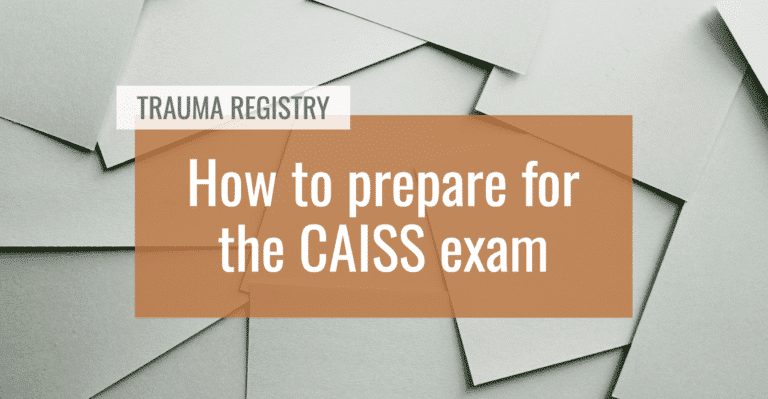One new requirement in Resources for Optimal Care of the Injured Patient (2022 Standards) is that every trauma center must have at least one trauma registrar who is a Certified Abbreviated Injury Scale Specialist (CAISS).
 While many trauma programs are already in compliance with this requirement (Standard 4.32), many other centers have had to work with registry staff to make sure at least one team member earns CAISS certification.
While many trauma programs are already in compliance with this requirement (Standard 4.32), many other centers have had to work with registry staff to make sure at least one team member earns CAISS certification.
If that person is you, you may feel a lot of pressure to pass the AIS Coding Specialist Certification (CAISS) Examination. Perhaps you are about to take the exam for the first time — or you may have already taken the exam once and failed. Either way, the key is to prepare intelligently.
The following approach to preparing for the CAISS exam is based on mastering the fundamentals of AIS and filling in your unique knowledge gaps.
Use official AIS resources
Be wary of CAISS exam preparation materials from unofficial sources. The fact is that some materials available online contain inaccurate information about the CAISS exam. For example, user-generated content available on Quizlet is not always reliable or appropriate.
We have also seen “CAISS practice tests” that are in a true/false format, not the multiple-choice format of the actual CAISS exam. This might seem like a minor point, but practicing for the exam in the wrong answer format will not help you prepare mentally for the actual test.
The only reliable way to prepare for the CAISS exam is to use official material from the Association for the Advancement of Automotive Medicine (AAAM) and the AIS Certification Board (AISC.B).
- AAAM materials include the Abbreviated Injury Scale 2005/2008 Update Dictionary (testing on the AIS 2015 Dictionary will begin in March 2026) and the course book from any of the association’s AIS courses. AIS course books include case scenarios that are very useful for understanding the principles and thought processes of AIS coding.
- The Candidate Handbook for the Certification Examination for AIS Coding Specialists is available from Professional Testing Corporation, the administrator of the CAISS exam. This handbook explains everything you need to know about the testing process (eligibility requirements, application procedures, exam day rules, etc.). It also includes a detailed outline of the exam content and provides several sample questions.
People sometimes ask whether a CAISS test prep course is available from Professional Testing Corporation. In short, no. AAAM courses are the authoritative educational resources for learning AIS and preparing for the CAISS exam.
Use the AIS Dictionary on the job
The single most effective thing you can do to prepare for the CAISS exam is to keep your AIS Dictionary at hand and use it regularly while abstracting trauma charts. This practice will help you learn and internalize the rules of AIS coding. It will also help you understand how AIS codes work hand in hand with anatomical terminology, medical terminology and injury descriptions.
There is an important corollary to this principle: Stop relying on the automated coder built into your center’s trauma registry software.
Automated coders do not incorporate the intricacies of the AIS rules, so they will generally lead you to not further specified (NFS) codes. This means two things:
- From the data quality point of view, you will not be capturing the true severity of your patients’ injuries. As a result, your trauma registry will be a less useful tool for trauma performance improvement and trauma research.
- From the point of view of your professional abilities, settling for NFS codes will mean that you never learn the fine points and nuances of AIS coding.

We recommend that you “personalize” your copy of the AIS Dictionary with notes, diagrams, definitions, illustrations and any other information that you find useful.
For example, if a patient chart includes an injury that you have not seen before, find an image of the injury online, print it out and add it to your dictionary binder.
At Kaiser Permanente Vacaville Medical Center, the trauma center that two of us (Amy and Jessica) call home, we have three CAISS professionals. What do we all have in common? We each have an AIS Dictionary that is marked up with personal notes, supplemented with extra resources, tabbed for easy reference and generally personalized with everything we have learned on the job about AIS coding.
If you have failed the exam, see your results notification
When you take the CAISS exam, you receive your results notification by email within 4 weeks. The results notification will include your results for each of the four major content areas of the examination:
- Anatomy
- Medical terminology as related to injury diagnoses
- Coding fundamentals
- Identification and coding of injury descriptions
If you have failed the exam, take a careful look at your results for each of these content areas — they will tell you where you need to put additional effort to improve your AIS knowledge and coding skills.
How to study for the anatomy section
Most candidates who fail the CAISS do so because of poor results in the anatomy section. While learning anatomy can be challenging, it is critical for accurate AIS coding. If you do not fully understand the anatomical structures affected by trauma, you will not know how to apply the AIS coding rules.
Effective ways to prepare for the anatomy section include:
Taking an anatomy course. Excellent anatomy courses for trauma registrars are available online. In addition, many community colleges offer courses in general anatomy.
Using anatomy flash cards. Use the flash cards on your own to learn anatomical structures in detail. Pair up with other registrars to solidify your knowledge by quizzing each other.
Getting an anatomy coloring book. If you are a tactile learner, taking the time to color in illustrations will help you master anatomy.
Watching videos online. Many video series are now available for learning anatomy. For example, see the Corporis channel on YouTube.
In general, review areas of anatomy that you may not see on a regular basis — such as arteries, veins and muscles — rather than injured structures you see day in and day out.
In addition, it is important to understand how the anatomical terms commonly used in your hospital may differ from “official” AIS terminology. (Note: AIS courses from the AAAM cover common variations in anatomical terminology that registrars may encounter.)
And as described above, make a habit of supplementing your AIS Dictionary with print-outs of anatomy illustrations that you find useful.
How to study for the medical terminology section
Medical terminology related to trauma includes basic terms like inferior, superior and anterior — and challenging concepts such as dissection versus transection, occlusion versus infarction, and dislocation versus subluxation.
There are two ways to prepare for the medical terminology section of the CAISS exam. The first is simply to go through the AIS Dictionary and look up every term you are not familiar with. The advantage of this approach is that it is very focused to the CAISS exam. In addition, this practice can be incorporated into your daily workflow.
The other approach is to take a medical terminology course. Many community colleges offer good introductory classes on medical terminology. Alternatively, your hospital may have a free online learning platform that includes a medical terminology module.
How to study for the coding fundamentals section
The best way to learn coding fundamentals is to study the rule boxes in the AIS Dictionary. You should also spend time reviewing your AIS course book, which contains many case examples that illustrate AIS coding rules.
In addition, consider re-taking an AIS course. Even registry professionals who understand AIS at a high level find that taking the course every few years is beneficial.
How to study for the injury descriptors section
The best way to master injury descriptors is to code difficult charts as a group, especially charts for complex injuries to the head, spinal column and pelvis. This practice generates dialogue about injuries and helps the entire team learn the most accurate descriptors.
Injury descriptor discrepancies discovered through your registry team’s interrater reliability process can also be a source of discussion and learning.
The use of 3D reconstructions of orthopedic injuries (allowing users to rotate the image) can be very helpful for visual learners.
And as always, use the AIS Dictionary! The index at the back is a great resource for understanding the different ways physicians might describe an injury and the proper way to identify it in AIS.
Take the official practice exam
A practice test for the CAISS exam is available online from Professional Testing Corporation. Visit the company’s AIS Certification page and click the “Take a Practice Test” button at the bottom.
General test-taking advice
All the usual advice for test taking applies to the CAISS exam — read and understand all examination rules and requirements ahead of time, get a good night’s sleep the night before the test, and arrive early on exam day. If you suffer from severe test anxiety, talk to your healthcare provider because medications may be helpful.
Don’t spend time on a question you are not sure about. If you can’t think through the answer in a few moments, flag the question and return to it later if you have time.
And finally, if an exam question includes an injury descriptor, use it to identify the correct answer. The goal during the exam (and during your daily work as a trauma data professional) is to capture the best description of the patient’s injury and its correlating AIS code. Avoid NFS codes when you have more detail available.
Amy Brammer, MSN, RN is the trauma program director and Jessica Pemberton, MSN, RN, CEN, TCRN, CAISS, CSTR is the trauma performance improvement coordinator at Kaiser Permanente Vacaville Medical Center, a Level II trauma center in Vacaville, California. Kathy Cookman, BS, CSTR, CAISS, EMT-P, FMNP is AIS Business Director/International Technical Coordinator for the Association for the Advancement of Automobile Medicine (AAAM) and CEO of KJ Trauma Consulting, LLC.


1 Comment
What’s your suggestion… I need a refresher course for Trauma Coding, last worked as a trauma Coder since 2016, I want to restart my career